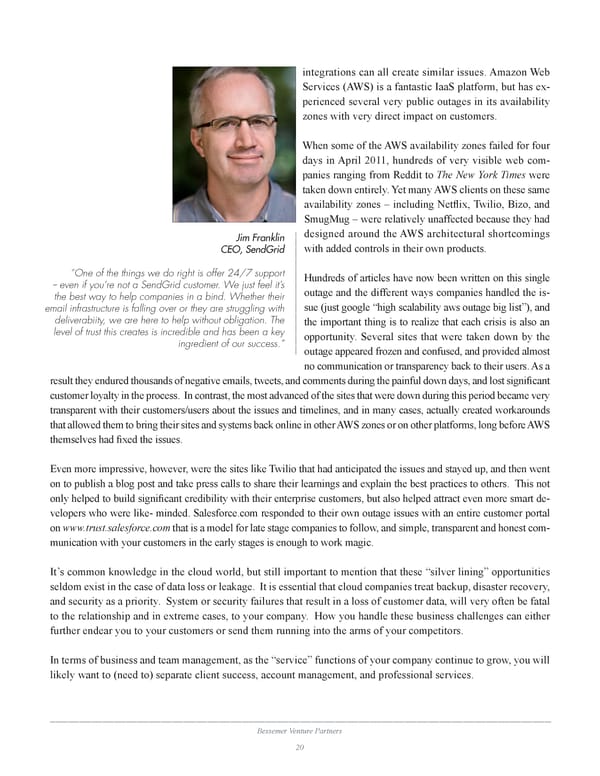integrations can all create similar issues. Amazon Web Services (AWS) is a fantastic IaaS platform, but has ex- perienced several very public outages in its availability zones with very direct impact on customers. When some of the AWS availability zones failed for four days in April 2011, hundreds of very visible web com- panies ranging from Reddit to The New York Times were taken down entirely. Yet many AWS clients on these same availability zones – including Netflix, Twilio, Bizo, and SmugMug – were relatively unaffected because they had Jim Franklin designed around the AWS architectural shortcomings CEO, SendGrid with added controls in their own products. “One of the things we do right is offer 24/7 support Hundreds of articles have now been written on this single -- even if you’re not a SendGrid customer. We just feel it’s outage and the different ways companies handled the is- the best way to help companies in a bind. Whether their email infrastructure is falling over or they are struggling with sue (just google “high scalability aws outage big list”), and deliverabiity, we are here to help without obligation. The the important thing is to realize that each crisis is also an level of trust this creates is incredible and has been a key opportunity. Several sites that were taken down by the ingredient of our success.” outage appeared frozen and confused, and provided almost no communication or transparency back to their users. As a result they endured thousands of negative emails, tweets, and comments during the painful down days, and lost significant customer loyalty in the process. In contrast, the most advanced of the sites that were down during this period became very transparent with their customers/users about the issues and timelines, and in many cases, actually created workarounds that allowed them to bring their sites and systems back online in other AWS zones or on other platforms, long before AWS themselves had fixed the issues. Even more impressive, however, were the sites like Twilio that had anticipated the issues and stayed up, and then went on to publish a blog post and take press calls to share their learnings and explain the best practices to others. This not only helped to build significant credibility with their enterprise customers, but also helped attract even more smart de- velopers who were like- minded. Salesforce.com responded to their own outage issues with an entire customer portal on www.trust.salesforce.com that is a model for late stage companies to follow, and simple, transparent and honest com- munication with your customers in the early stages is enough to work magic. It’s common knowledge in the cloud world, but still important to mention that these “silver lining” opportunities seldom exist in the case of data loss or leakage. It is essential that cloud companies treat backup, disaster recovery, and security as a priority. System or security failures that result in a loss of customer data, will very often be fatal to the relationship and in extreme cases, to your company. How you handle these business challenges can either further endear you to your customers or send them running into the arms of your competitors. In terms of business and team management, as the “service” functions of your company continue to grow, you will likely want to (need to) separate client success, account management, and professional services. Bessemer Venture Partners 20
 Bessemer’s Top 10 Laws of Cloud Computing Page 19 Page 21
Bessemer’s Top 10 Laws of Cloud Computing Page 19 Page 21